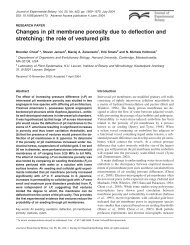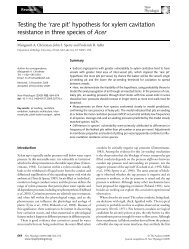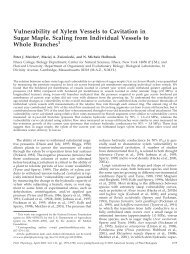View - ResearchGate
View - ResearchGate
View - ResearchGate
Create successful ePaper yourself
Turn your PDF publications into a flip-book with our unique Google optimized e-Paper software.
90 A. Vilagrosa et al.studies have analyzed for variations in vulnerability to cavitation among populationsin forestry species (Tognetti et al. 1998; Martínez-Vilalta et al. 2009; Herbetteet al. 2010; Corcuera et al. 2011). The results of these works are contrastedand reflect a high intraspecific phenotypic plasticity. Furthermore, Corcuera et al.(2011) found a good convergence between hydraulic traits, xylem embolism, anddrought tolerance of the populations. Therefore, the adjustment of hydraulicproperties at leaf and shoot level can play an important role in avoiding cavitationrisks (Martínez-Vilalta et al. 2009).At the cultivar level, few studies have focused on the variability within a singlespecies found over a broad range of environmental conditions. However, Alsinaet al. 2007 compared eight 10-year-old grapevine cultivars and found large differencesbetween them based on their sensitivity to drought-induced cavitation.Franks et al. (1995) reported that seedlings of Eucalyptus camadulensis from drierenvironments in Australia exhibited higher resistances to drought-induced xylemcavitation compared with seedlings from wetter environments.3.3.6 Coordination of Processes Between Cavitationand Cell and Leaf FunctionThe vulnerability of xylem to cavitation (i.e. apoplastic resistance) is a keyparameter for understanding the role of hydraulic architecture in leaf and wholeplantfunction. This parameter has been associated with variations in any plantfunctional traits that controls cell and plant functionality (Vilagrosa et al. 2010).Specifically, photosystem II (PSII) functionality, photosynthetic pigment composition,cell membrane integrity, and protein stability play an important role in cellresistance to drought stress at symplastic level. Thus, under intense drought andtemperature stresses, energy dissipation mechanisms could be promoted, mediatedby changes in the de-epoxidation state of the xanthophyll cycle (Morales et al.2006) and/or photoinhibition in the photosynthetic apparatus of water-stressedleaves (Demmig-Adams and Adams 2006). Moreover, many phospholipids ofbiological membranes undergo phase transitions and membrane fusions that aredisruptive to membrane structure and function. For these reasons, cell membranesare also considered as one of the first targets of many stresses, and maintenance oftheir integrity and stability under water stress conditions is a major component ofdrought tolerance in plants (Earnshaw 1993).The production of a xylem with a great resistance to cavitation, which demandshigh investments in construction costs (Pratt et al. 2007; McCulloh et al. 2011),would be accompanied by a high tolerance at leaf level to drought conditions bymeans of some adaptive processes, multigene expression or regulatory networks(Valliyodan and Nguyen 2006). Thus, the functional coordination between theresistance to xylem cavitation and the response of stomatal processes has beenstudied by several authors, establishing the concept of ‘‘safety margin’’ i.e., the
















